Darrell Brooks trial: Police, defendant's girlfriend's roommate testify

Darrell Brooks trial: Police, defendant's girlfriend's roommate testify
The prosecution called its first two witnesses Thursday afternoon in the trial of Darrell Brooks, accused in the Waukesha Christmas parade attack: Waukesha Police Sgt. David Wanner and Kori Runkle, the roommate of Brooks' girlfriend.
WAUKESHA, Wis. - Opening statements began Thursday afternoon, Oct. 6 in the trial of Darrell Brooks, accused in the Waukesha Christmas parade attack. The state then called its first two witnesses: Waukesha Police Sgt. David Wanner and Kori Runkel, the roommate of Erica Patterson, Brooks' girlfriend. The jury was sent home after a 10-hour day.
The day started Thursday morning much like the prior three did with interruptions from Brooks. Ten hours later, the judge complimented Brooks, and the defendant thanked the judge for her comments.
Within moments of the proceedings getting underway Thursday at 8:30 a.m., Brooks interrupted Judge Jennifer Dorow multiple times.
The judge attempted to get through final court procedures before bringing in the jury for jury instructions before the opening statements and could not do so because of Brooks' interruptions. She indicated if Brooks did not stop the interruptions, he would be removed from court.
"This is Day 4, and every day, he has interrupted and resulted in him being placed in a nearby courtroom," said Judge Dorow.
The judge noted there is a proper way to raise objections.
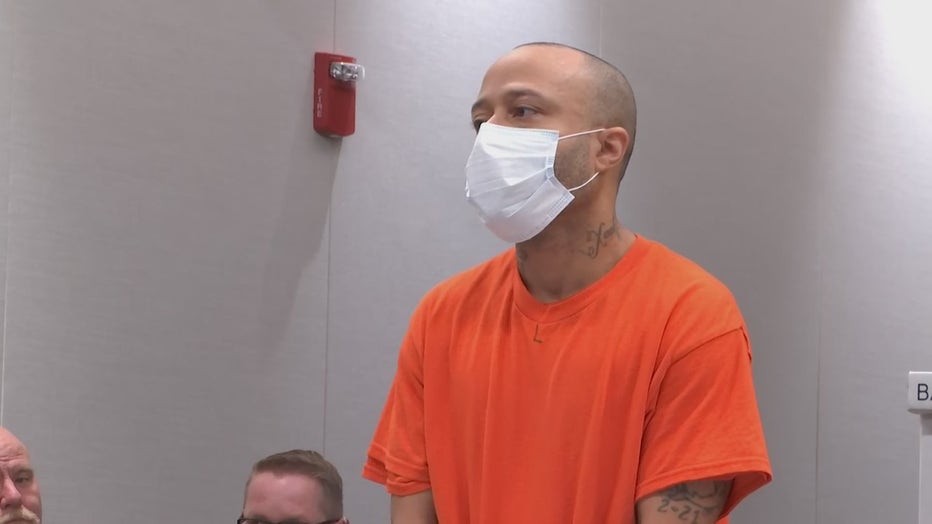
Darrell Brooks
The judge also asked Brooks if he would be willing to go back to his cell to change into street clothes instead of wearing his jail-issued orange clothing. Brooks said he did not think that was necessary because as he noted, everyone knows he is in custody for this case. Brooks referred to the many media reports.
"There’s no possible way that people will not know I am in custody," Brooks said to the judge.
Darrell Brooks trial timeline: Day 4
Below is a timeline of Thursday's events per court records:
8:25 a.m.: Case called for Day 4 of jury trial
Brooks declined to put on street clothing
8:42 a.m.: Brooks moved to adjacent courtroom after more than a dozen interruptions
Dorow says sheriff would file report on Brooks' behavior
9:09 a.m.: Brief recess for Polycom system in adjacent courtroom to be addressed
9:18 a.m.: DA Sue Opper notes "complete confidence" in Brooks' competency
Dorow agrees, saying Brooks' behavior was intended to "make a mockery of the court"
Preliminary jury instructions approved
9:49 a.m.: Brooks declines offer to return to main courtroom
Brooks wouldn't respond to requests to qualify his objection
Judge discussed Brooks' objections
State's motion for reconsideration regarding showing witnesses' faces on the trial broadcast denied
10:09 a.m.: Brooks declines offer to return to main courtroom until he can see a nurse; claims finger cut and arm bruise during removal from court
Brooks again declines to change into street clothing
10:19 a.m.: Jury enters
Preliminary instructions read to jury
11:55 a.m.: Jurors sent to lunch
Brooks' two objections/notes submitted during jury instructions are scanned into the record
Brooks reminded he was welcome back into the main courtroom if he behaved and was again offered the chance to change into street clothing
12:00 p.m.: Lunch recess
1:11 p.m.: Brooks requested to return to the main courtroom and was moved
1:22 p.m.: Brooks repeatedly interrupted the court while being warned not to
1:36 p.m.: Jury re-entered
Preliminary jury instructions continued
2:20 p.m.: Juror break
2:44 p.m.: Brooks moved to adjacent courtroom
2:56 p.m.: Brooks' objections/notes during jury instructions were addressed
Brooks was invited back into the courtroom and was non-responsive
3:21 p.m.: Jury returned
Zachary Wittchow makes opening statement for state
Brooks defered his opening statement until a later point
4:05 p.m.: Discussion about calling witnesses
Brooks invited back into the main courtroom and was non-responsive
4:18 p.m.: Jury returned
Waukesha Police Sgt. David Wanner testified
Kori Runkel, Brooks' girlfriend's roommate testified
5:38 p.m.: Brooks requested to return to the main courtroom and was moved
5:48 p.m.: Jurors returned after Brooks was moved
6:36 p.m.: Jury read a modified version of Jury Instruction 50 regarding partial sequestration
6:40 p.m.: Court adjourned until 8:30 a.m. Friday, Oct. 7
Brooks removed from court, takes off shirt
At 8:40 a.m., Judge Dorow ordered Brooks removed from the courtroom and placed in the adjacent courtroom so that the proceedings could continue as originally planned. Moments later, the court went into recess.

Darrell Brooks
When court came back into session, Brooks was seen by video from an adjacent courtroom. He was shirtless. Judge Dorow made a note for the court record that he had been defiant and disruptive.
Dorow said she filed a written report with the court, saying Brooks was resisting his removal, noting "at one point, he took off a shoe."
"He took his shirt off, as well. He made claims he would throw and break things," the judge said.
Brooks had his back to the camera in the adjacent courtroom.
"I would note it’s after 9:06 a.m... Mr. Brooks still appears to be communicating with someone else. I can tell he can hear me. He shakes his head no. I believe he can adequately hear, and his statement that he is hard of hearing is simply another tactic to delay and create chaos," the judge said.
Brooks' interruptions Thursday morning were much the same as they have been, saying he doesn't acknowledge the name Darrell Brooks, telling the judge, "I don't identify by that name."
The judge noted that the continuous objections about his name don't need to be acknowledged every day, saying, "I’ve made a record."
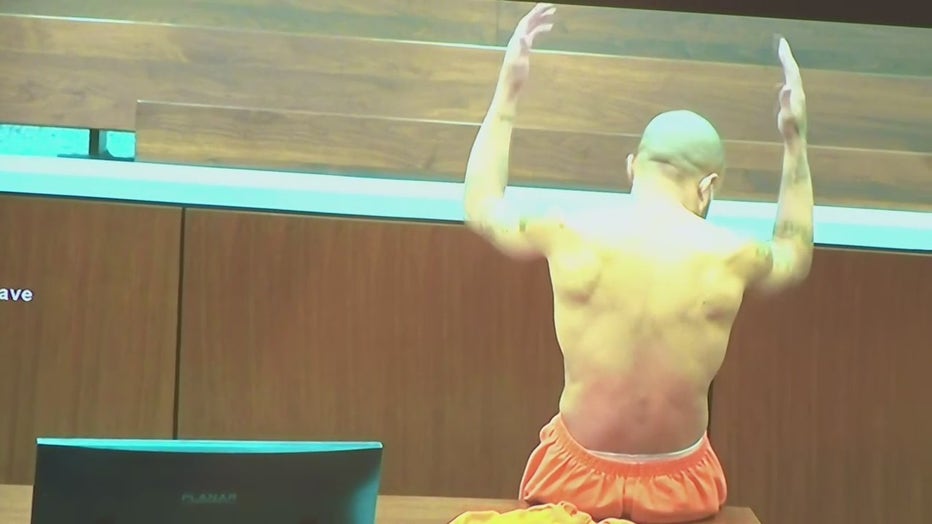
Darrell Brooks
SIGN UP TODAY: Get daily headlines, breaking news emails from FOX6 News
Waukesha County District Attorney Sue Opper noted for the record no competency concerns related to Brooks. Dorow agreed, saying she reviewed four evaluations of Brooks and that examiners met with Brooks as recently as July and August.
"Frankly, the behavior here is more in line with someone who is defiant and deliberate," Judge Dorow said. "It is the sole intent of Mr. Brooks to make a mockery of this court."
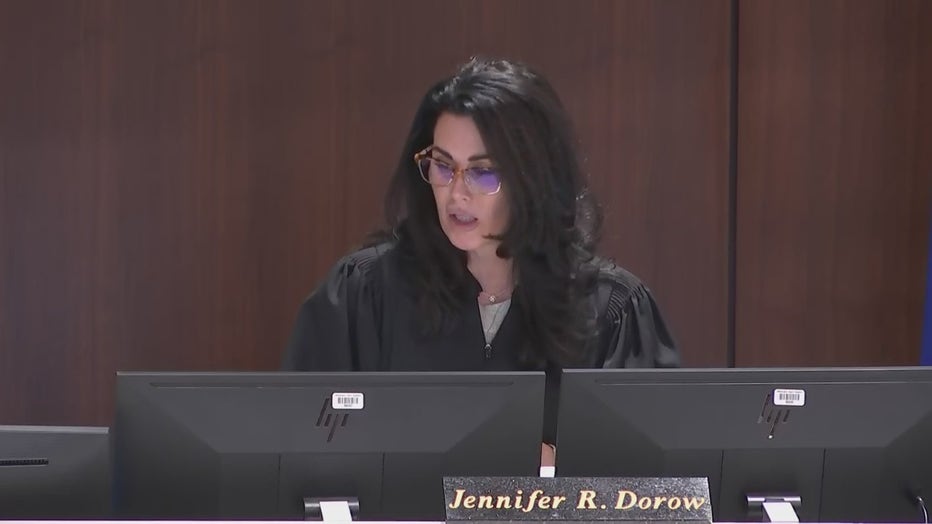
Judge Jennifer Dorow
Before the judge could continue, it was noted Brooks had technical issues with his microphone, and court was recessed once again.
State's motion to reconsider victim witness' faces on camera denied
When court was back in session, Brooks said he required medical attention for a cut on his finger and made reference to a bruise on his arm he said he sustained when he was removed from the courtroom. Dorow said there were no signs of blood, and Brooks said it was because he wiped it on his jail uniform. Dorow said he would see jail medical staff during the lunch break.
Shortly before 10 a.m., there was a discussion about whether victims' faces would be shown in the trial broadcast following a motion for reconsideration from the state. Opper said "not having faces displayed would help ease some tension with those individuals."
Brooks was asked if he had comment on the matter, and he noted that this is a "public trial."
"Everything is supposed to be public," said Brooks. "I don’t understand why there’s reconsideration. This is a public trial."
Dorow denied the motion for reconsideration, ruling all victim/witness names are a matter of public record.
At this point, Dorow said she offered to allow Brooks to come back into the main courtroom. Brooks said that wasn't accurate, instead bringing up his need to have his medical concerns addressed. The judge gave him another chance to change into his suit and tie, and he declined.
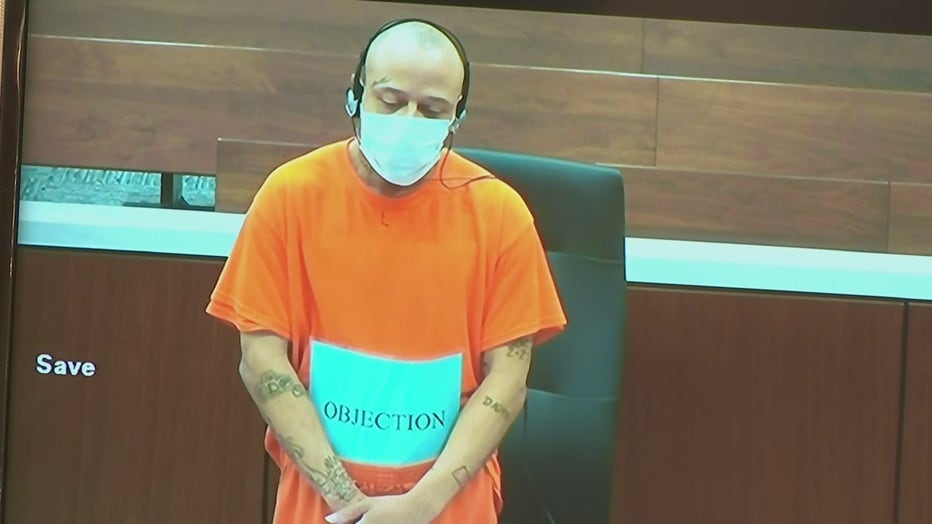
Darrell Brooks objects during the reading of jury instructions
Jury instructions, pages 1-44
Shortly before 10:30 a.m., Dorow began reading jury instructions, a lengthy process as she had to lay out all 76 charges against Brooks one by one. Brooks was seen raising an objection card from the adjacent courtroom. His microphone was muted the entire time.
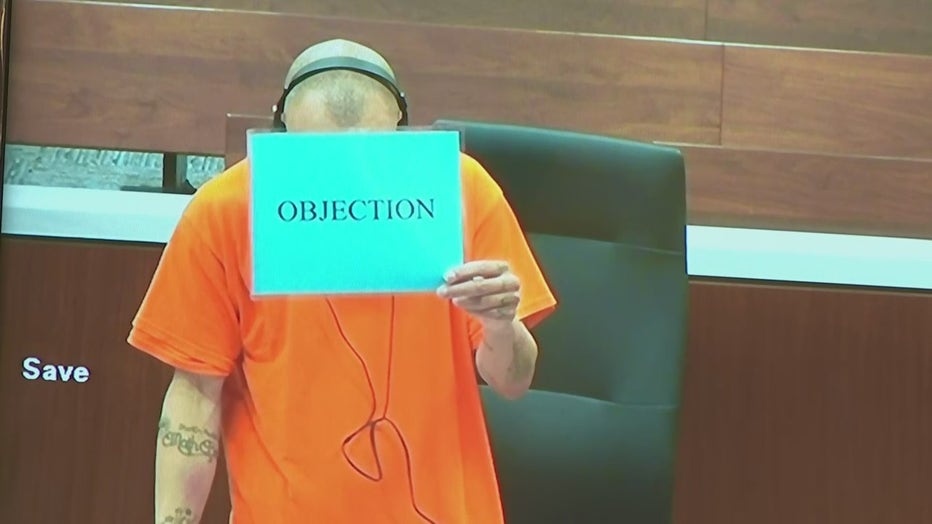
Darrell Brooks objects during the reading of jury instructions
The process led into the lunch hour around noon, before which Dorow addressed Brooks' two written objections to the jury instructions.
The judge noted that during the lunch break, Brooks would be seen by jail medical staff and again have the option to change into street clothing.
The judge sent the jury out for lunch shortly before noon and put the court in recess. Forty-four of the 69 pages of jury instructions were read before lunch.
Brooks returns to main courtroom, argues with Dorow
When court was back in session after lunch, Brooks told the judge around 1:15 p.m. that he did want to return to the main courtroom. There was then a recess, so he could be moved.
Brooks was reminded again that he must write down any objections during the reading of the jury instructions and the judge would consider them outside the presence of the jury. There was a back-and-forth between Brooks and Dorow again, with Brooks wanting his objections addressed. Brooks was informed this was not the evidentiary portion of the trial. The judge told him he would have the opportunity to present his case-in-chief after the state presented theirs.
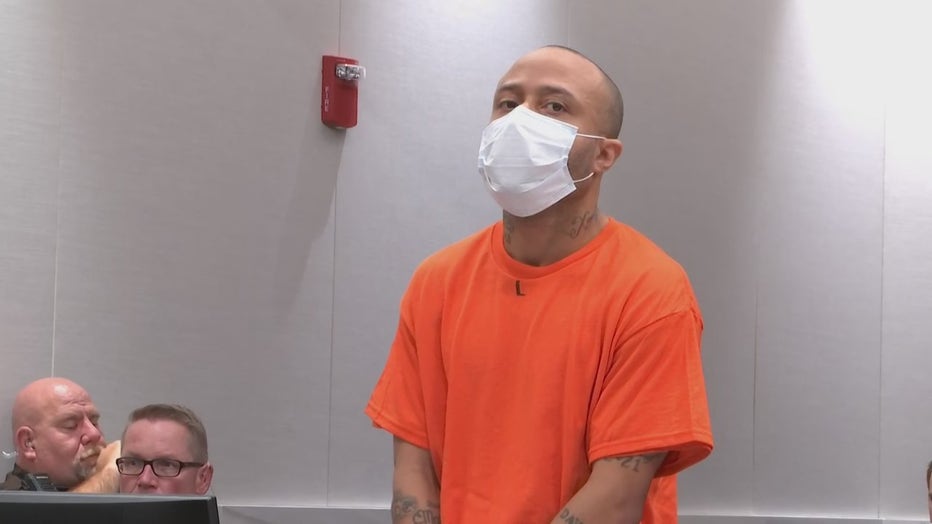
Darrell Brooks
Dorow told the court she intended to finish reading the jury instructions, take a break and come back Thursday afternoon with opening statements.
At 1:28 p.m., Brooks told the court he wished to return to the adjacent courtroom. He again told the judge he did not understand "the cause and nature of the charges." Dorow again reminded Brooks that she cannot give him legal advice. She warned him she could admonish him with the jury present.
Brooks said he wanted to discuss "subject matter jurisdiction." Dorow called this "a tactic," and she said it "demonstrates" that Brooks had "no intention of following the rules" after he was moved back into the main courtroom after lunch.
Brooks told the court he was being "rushed to judgment by moving me," noting that he "has a right to be present during these proceedings." He said he "merely" wants clarification on things.
"I don't understand what is going on," said Brooks. "It's not to be disrespectful."
Jury instructions, pages 44-69
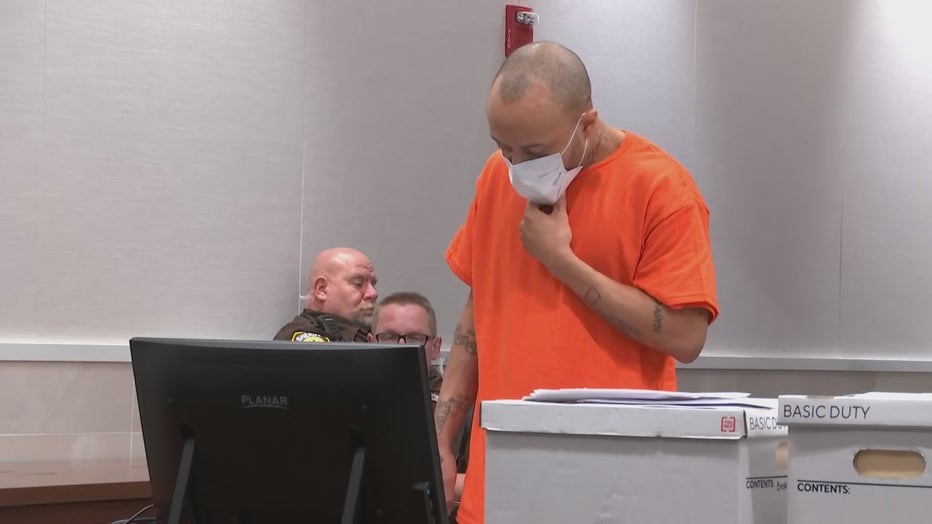
Darrell Brooks
Dorow again reminded Brooks of the waiver form allowing him to represent himself. She gave him a "final warning" as the jury was brought in, telling Brooks she was going to resume reading the jury instructions. Brooks briefly talked over the judge as she started reading, but then he was quiet.
Brooks says he recognizes a juror

Darrell Brooks trial: Defendant tells the court he recognizes one of the jurors
Darrell Brooks told Judge Jennifer Dorow on Oct. 6 that he recognized one of the jurors picked for the case from a previous incident. Here is that exchange.
The court recessed around 2:30 p.m. to address some legal issues.
Brooks told the judge that he recognized one of the jurors from his initial appearance.
"She flipped me off," Brooks said. "I don't want that to end up being an issue."
The judge reminded Brooks that he had an opportunity to make 10 peremptory strikes. He made two and refused eight. Those eight were randomly picked by the court clerk.
Brooks said he could only see the judge and the prosecutors' table from the adjacent courtroom during the voir dire.
"There was no way for me to see who the jury was," said Brooks. "Obviously, I wouldn't know them by name."
Dorow said she would have the civilian bailiff ask that juror whether Brooks' accusation was true. She later said it was confirmed by the juror she did not attend any proceedings in this case.
"That will address your issue with her," said Dorow.
Brooks objected.

Darrell Brooks trial, attorney breaks down behavior
Attorney Ben Lutgen with Kim & LaVoy, who is not associated with the case, joined FOX6 News to discuss Darrell Brooks' behavior and disruptions in court on Thursday. Specifically, what it means regarding his competency status and potential delays of trial.
Brooks moved to own courtroom again
Brooks and Dorow then argued over other objections written by Brooks during the reading of the jury instructions. Dorow later noted she received five objection "filings" from Brooks during jury instructions.
At 2:42 p.m., Dorow again gave Brooks a "final warning" after continuous interruptions. Brooks asked the judge whether she is "making a judicial determination not to honor my (constitutional) right."
"You have an obligation to treat this court fairly, and you have an obligation to follow the rules and decorum of this court," Dorow said, again.
The judge noted that she was giving Brooks "some leeway," but he continued to talk over her. Recess was called at 2:45 p.m. so Brooks could be moved to the adjacent courtroom again.
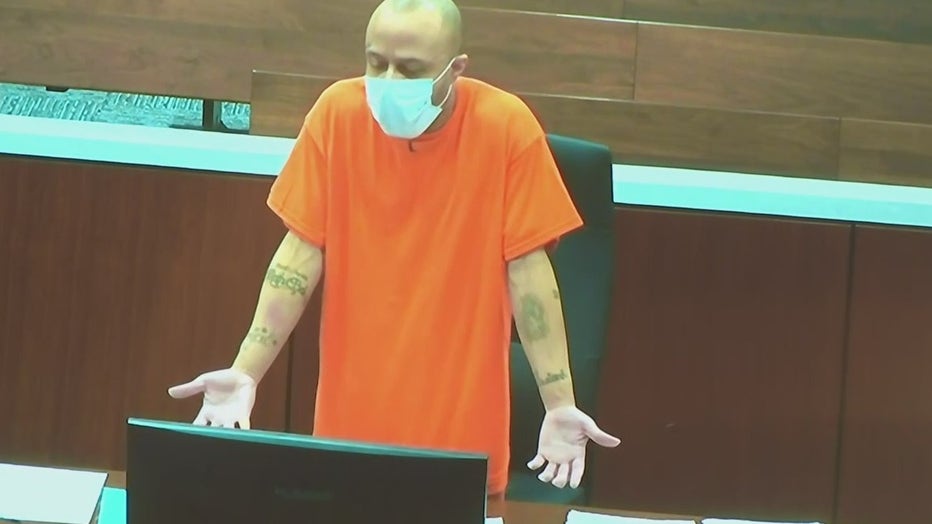
Darrell Brooks in court Oct. 6 ahead of opening statements
Shortly before 3 p.m., Brooks was back in the adjacent courtroom.
Dorow addressed Brooks after muting him due to more interruptions, saying she was "so pleased when you were able to follow the simple rules when the jury was here, and we were going through those instructions…then you started in with your antics, with your interruptions."
She noted that it doesn't matter whether he's raising his voice or talking in a mild-mannered tone of voice; the court can make a finding that his behavior is disruptive.
At this point, Opper argued Brooks' "sovereign citizen" defense has no conceivable validity in American law. This involves things like Brooks' comments regarding his name, the fact that he doesn't identify a person and his desire to call the State of Wisconsin to the stand (entity vs. person). The court agreed with prosecutors. Judge Dorow denied all related "sovereign citizen" filings.
Dorow said she would be using the name on the official charging documents related to this case: Darrell Brooks.
With jurors set to be brought back in for opening statements, Dorow offered Brooks the opportunity to move back into the main courtroom.
"You want me to come over there just to get brought back over here?" Brooks asked.
He was again reminded of the need to follow court decorum.
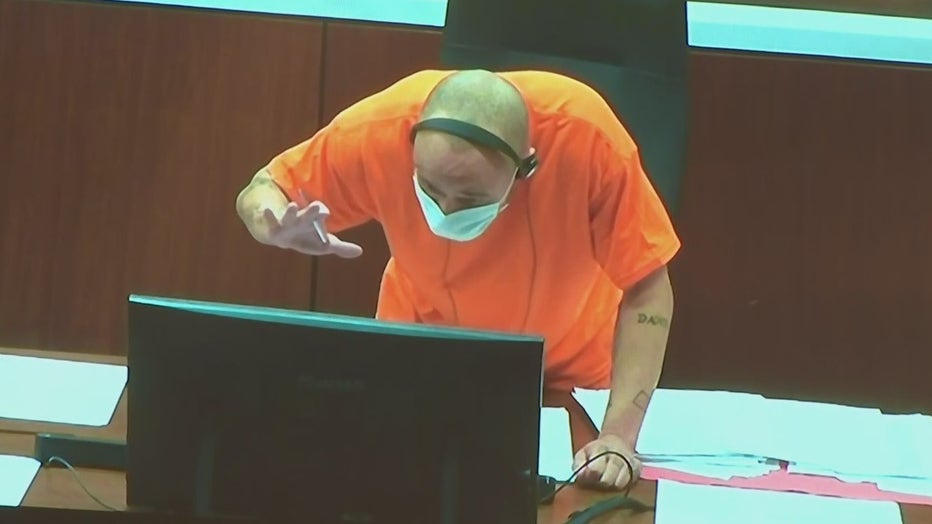
Darrell Brooks in court Oct. 6 ahead of opening statements
Brooks argued he "cannot put on an adequate defense if I don't understand."
"Forgive me for being this way, but if I don't understand, I'm going to ask questions," said Brooks. "You haven't answered anything I've asked you, and I have to answer everything you've asked me. I just want it to be fair."
Brooks said he's "not asking for legal advice."
The judge reminded Brooks again that he waived his right to an attorney, and they were not going to discuss these issues in the middle of a trial.
She noted that she is not obligated to answer questions that explain court procedure or the law. She said she is obligated to address motions based in law and fact and to address objections to testimony, evidence and questions posed to witnesses, but she is not obligated to provide an explanation of law/procedure.
The jury was then brought back in for opening statements.
Prosecutors' opening statement: Assistant District Attorney Zachary Wittchow

Darrell Brooks trial: Prosecution opening statement (part 1)
Darrell Brooks trial: Prosecution opening statement (part 1)
Assistant District Attorney Zachary Wittchow delivered the opening statement for the prosecution.
The court went into recess so that they could set up a shared screen, with the state set to use a PowerPoint presentation and Brooks in the adjacent courtroom.
"The events started off normal. There were dance teams, high school marching bands, local businesses all making their way down the parade route," said Wittchow. "The streets were lined with friends and family members and neighbors; people there to soak up the atmosphere. Kids ran into the street to pick up candy. It sounds corny, but I think you’ll see from the videos, there was a sense of joy in the air. Darrell Brooks killed that joy. He replaced it with terror…and death."
"He hit the gas with his red Ford Escape and used it as a battering ram over and over again, striking men, women and kids. In the end, Mr. Brooks killed six people. He injured dozens more and left a permanent scar on this community," Wittchow continued.

Darrell Brooks trial: Prosecution opening statement (part 2)
The prosecution team in the Darrell Brooks trial finished up its opening statement -- making way for the start of the trial. Brooks has opted to defer his opening statement until he begins his defense.
Wittchow said he’d set the scene with the Waukesha police incident commander for the parade. He showed a map of downtown Waukesha.
From that, Wittchow said they’d move into the origin of Brooks’ rage that day – a violent domestic argument with Erica Patterson, his former girlfriend and the mother of his child. Wittchow said Patterson would be testifying.
"On the day in question, he showed up, argued with her, harassed her and punched her in the face," said Wittchow, adding, "The thing about a swollen eye is that it’s tough to fake."
A picture was shown.
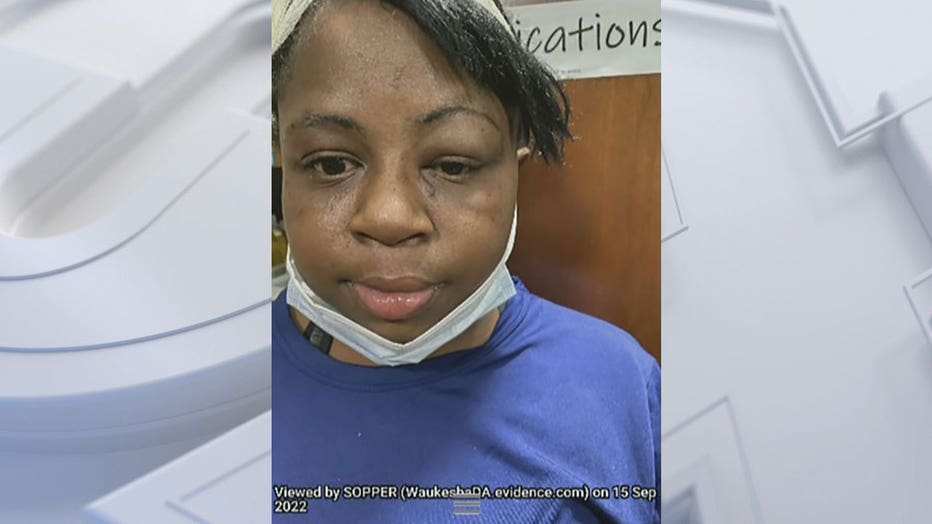
Erica Patterson
Wittchow said Brooks took her all over town that day. Patterson called her roommate for help. He said the roommate found Patterson and Brooks in front of White Rock School and she and Brooks yelled at each other, caught on camera.
"You’re going to see how the defendant reacted when Erica’s friend showed up, and he lost his physical advantage over a woman," said Wittchow. "The evidence is going to show Brooks must have known once things got loud and once there was more than just him and Erica on scene, the police would show up, so he took the coward’s way out."
"You’re going to see him get into the driver’s seat… and you’ll see him pull off," Wittchow added.
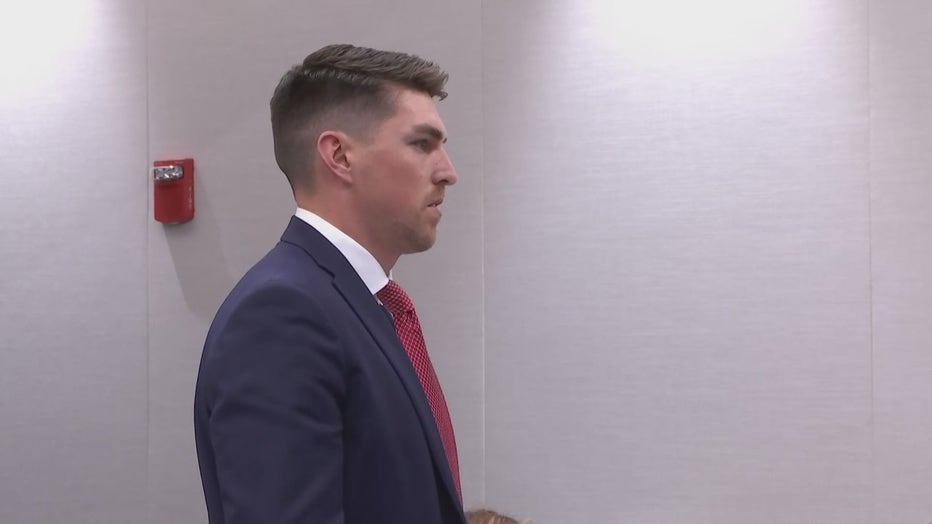
Zachary Wittchow, Waukesha County Assistant District Attorney
Wittchow said the jury would also hear from law enforcement along the parade route, including the first officer who tried to stop Brooks, coming into contact with the red SUV "face to windshield."
"He tried to stop the defendant, but there’s only so much a man can do against an SUV," Wittchow said. "He can definitively say Mr. Brooks, the man in orange, was the man driving that SUV."
Wittchow said firefighters would talk about the massive medical response, triage, victim care, mutual aid call to all other communities and how Waukesha Memorial Hospital quickly reached capacity.
"We’ll transition into the next chapter of this story," Wittchow said. "You’re going to hear about how some people’s lives were changed forever that day."
He talked about the first witness, Nicole White, the first victim struck.
"She’s going to tell you that she was marching with her friends and co-workers when, without any warning, she was hit from behind. You’re going to see video of that," said Wittchow.
As the first person struck, Wittchow said she represents the point in time when Brooks was legally required to stop.
"Not only did Brooks not stop, the evidence will show he sped up," said Wittchow. "The evidence will show as the body count increased, so did his motive to get away."
Wittchow then talked about the Waukesha South Marching Band.
"Ten kids in that band were either hit or run over," said Wittchow.
He said the band director would testify, addressing video.
"It’ll be clear as day who is getting run over or hit," he said. "It will be clear as day whose safety was in danger that day."
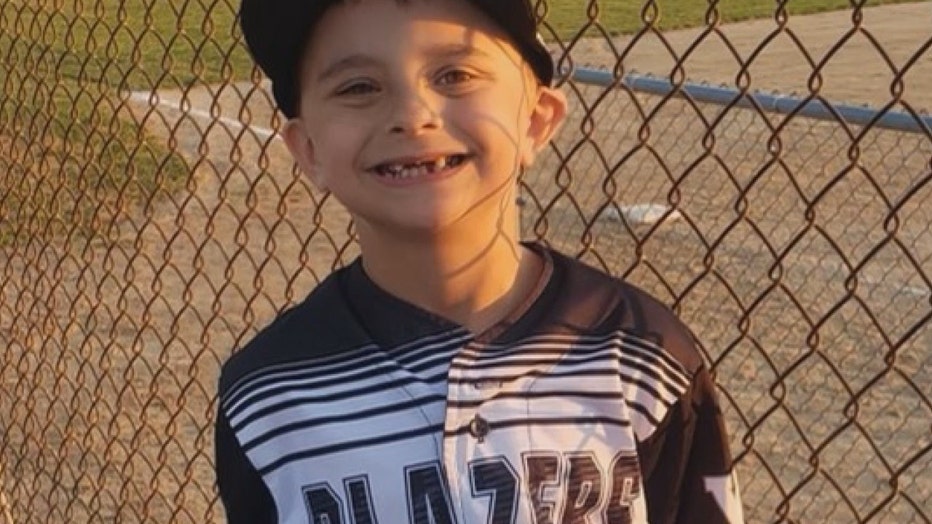
Jackson Sparks
Moving down the parade route, Wittchow discussed the Waukesha Blazers.
"At this point, when we get to the Blazers, the defendant will have already hit 15 people," said Wittchow.
Five members of the youth baseball team were hit, including Jackson Sparks, 8, who later died. He was walking in the parade with his big brother, Tucker, who was hurt.
Wittchow discussed the Waukesha Xtreme Dance Team, consisting of dancers of all ages. Fifteen members of the group got hit or were nearly hit.
He talked about Jane Kulich, marching with friends and co-workers with Citizens Bank. Wittchow said this is the only homicide where there is no clear video of her death.
The prosecutor then talked about the Milwaukee Dancing Grannies.
"They will describe seeing pom poms in the air, and the next thing they knew, there were bodies on the ground before the pom poms hit the ground," said Wittchow.
Wittchow said Brooks swerved around the grannies and hit Willhelm Hospel and Tamara Durand. It was Durand's first parade.
Lee Owen was right next to her. Wittchow said the group had just begun one of her favorite routines, "Walking in a Winter Wonderland."
Ginny Sorenson was walking at the front of the group, carrying the banner. Normally, she rode in the back of the vehicle so she could critique. She filled in at the last moment that day.
Hospel, Durand, Owen and Sorenson were killed.
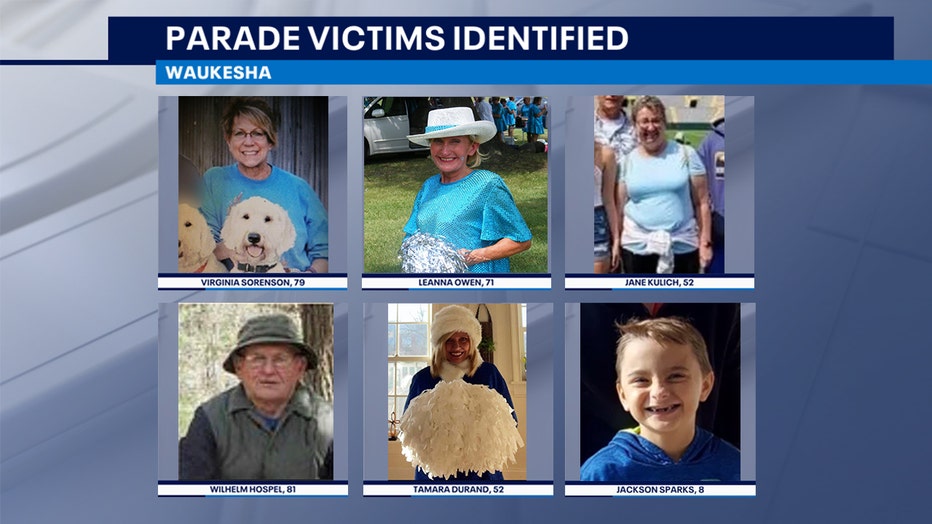
Waukesha parade attack victims identified
Wittchow said the eighth and final group struck was the Catholic Community of Waukesha. There were 19 victims from this group.
"You can see the defendant’s taillights swerving from the left to the right. You can see them bouncing up and down," said Wittchow. "There are no speed bumps in this section of the road."
The prosecutor said an officer who fired three rounds at the SUV would testify. All three rounds hit the vehicle. None hit Brooks.
He said jurors would hear from Daniel Rider, who was one of two people Brooks ran up to after ditching the SUV.
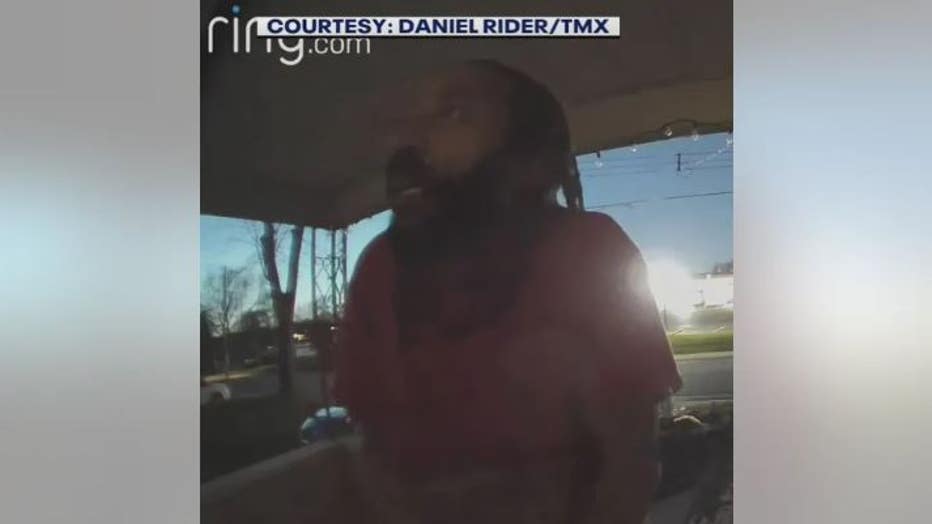
"The defendant showed up to his door without any shoes on, without a T-shirt… said he needed to use the phone," said Wittchow.
The man let Brooks in, and two minutes later, the police showed up to arrest Brooks. Wittchow said they found the SUV's key in Brooks' pocket. He said Brooks' DNA was on the Escape's steering wheel.
He added that jurors would be taken to see that red SUV with their "own eyes."
He said the counts related to homicide will be supported, along with each count of attempted homicide and each count of recklessly endangering safety.
"If yes, you have to answer if he used a dangerous weapon. He used 3,500 pounds of steel, rubber and glass," said Wittchow.
Brooks declines opening statement ‘at this time’
Brooks was asked if he'd be making an opening statement.
"I will be declining at this time," said Brooks.
He said he needed more time to go through things.
Thursday afternoon testimony
Before the jury was brought back in for testimony after 4 p.m., Brooks and Dorow again argued after the judge asked Brooks if he wanted to return to the main courtroom. Dorow asked him multiple times if he would be willing to abide by the decorum of the court, and Brooks said he had been. Brooks eventually refused to answer the question with a "yes" or a "no," so the jury was brought in and Brooks remained in the adjacent courtroom.
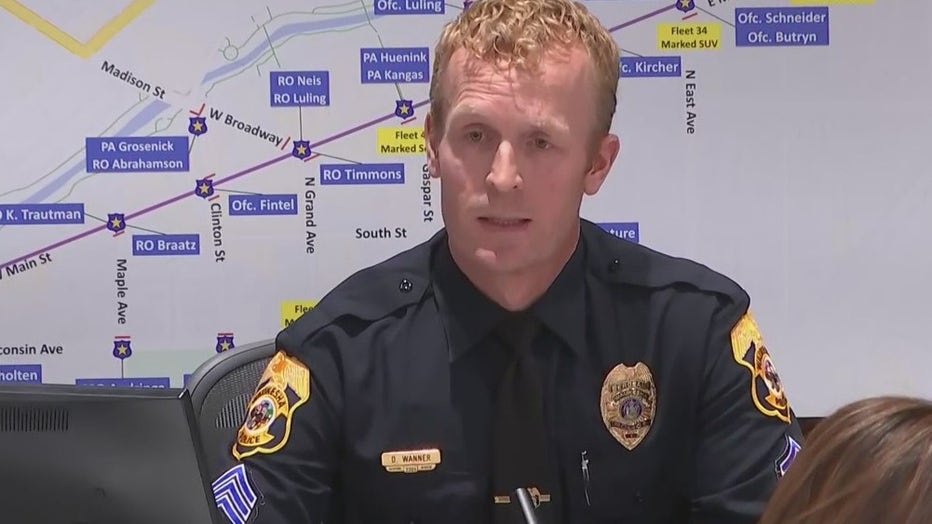
Waukesha Police Sgt. Dave Wanner -- first witness for the state
The first witness for the state was Waukesha Police Sgt. Dave Wanner.
Sgt. Wanner talked about the parade route, referencing the map. He pointed out where police were located, where barricades were located, what time officers arrived and things that were done to ensure the parade route was secure.
Brooks objected multiple times during Wanner's testimony.
Wanner talked about hearing about a fight at Frame Park over the police radio involving "knives."
He said as he made his way back to his unmarked squad, he saw a red SUV speeding toward him as he looked toward White Rock Avenue. He said he thought it was going over 40 miles per hour in the 25 miles per hour zone.
Wanner said he waved both of his hands to try to get the driver's attention. He estimated he was six feet away from the SUV, which passed in front of him. He said the driver was in a "dazed, straight focus ahead" position.
Opper asked Wanner if the driver responded, and Wanner said no.
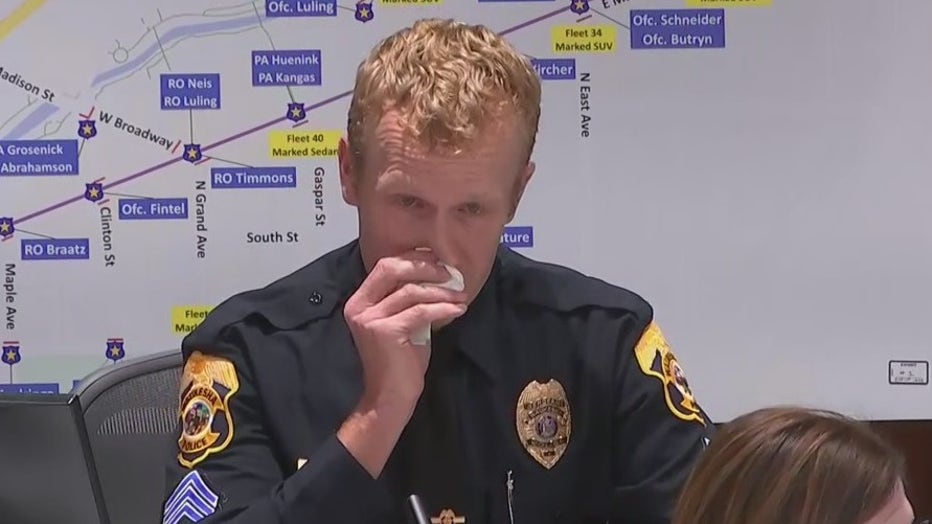
Waukesha Police Sgt. Dave Wanner emotional as he testifies in Darrell Brooks' trial Oct. 6
He said the SUV passed him and entered the parade route. He said he only watched it for a short period of time before returning to his squad, knowing police action was needed. When asked what he did, Wanner said he was bombarded with… "the most terrible thing I ever heard."
Wanner said the call for help essentially asked for any available officer in the county to come to the scene.
Brooks cross-examines Sgt. Wanner
Darrell Brooks then cross-examined Sgt. Wanner.
"I see this is very emotional, so I’m going to do my best not to keep you up there any longer than you would like to be," said Brooks.
The state objected to multiple questions asked by Brooks.
Brooks asked if Wanner could be shown a short video clip also shown to Wanner by the state.
"Is it fair to say that you can see that there are people walking in the street and on the sidewalk?" asked Brooks.
"Yes, I can see that in the video clip," said Wanner.
Brooks asked if Wanner saw anyone being targeted or in a panic to get away from the vehicle. Wanner answered, "No."
Brooks asked if Wanner saw the SUV's driver intentionally try to hit anyone. Wanner answered, "No."
The defendant asked if Wanner was brought to testify on behalf of the plaintiff. An objection by the state was sustained.
Brooks asked Wanner if he could see the plaintiff (the state) in court. Objections by the state were sustained.
Brooks had no further questions. There was no redirect examination from the state.
Brooks' girlfriend's roommate testifies as state's second witness
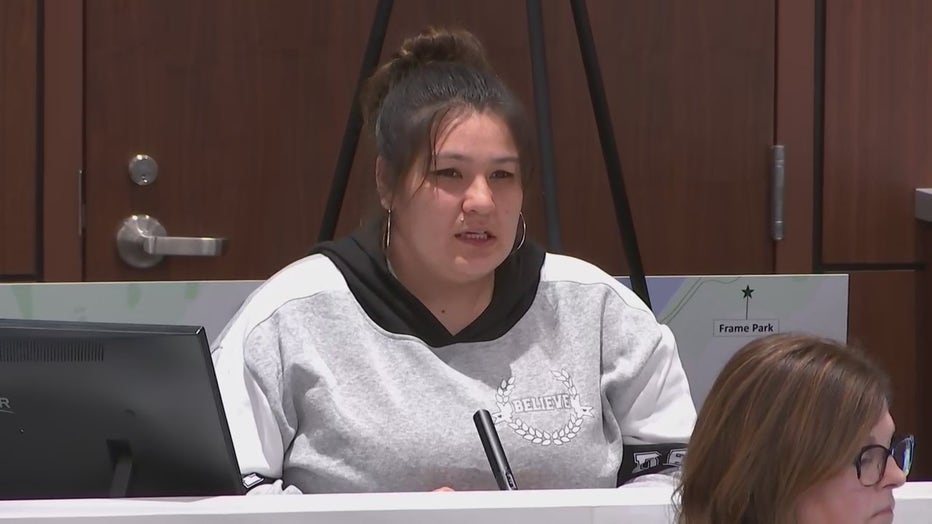
Kori Runkel, Erica Patterson's roommate, testifies Oct. 6
The state's second witness was Kori Runkel. She knows Erica Patterson, Brooks' girlfriend, from the Waukesha women’s shelter in October or November 2021.
Runkel talked about the Frame Park fight between Brooks and Patterson before the parade attack. Runkel said she had never met Brooks before that day.
She said Patterson called her, and Brooks was "beating her up and following her." Runkel said she and Nick, a man she was with, started running to the area near White Rock School where Brooks and Patterson were. She said Brooks was "swerving into" Patterson. She said Brooks was yelling at Patterson to get back into the car, but Runkel said, "I wouldn't let her."
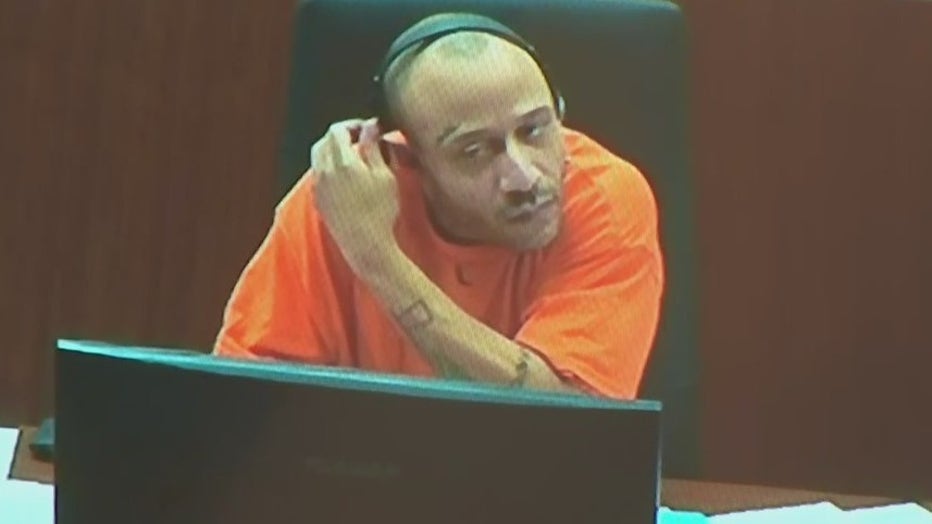
Darrell Brooks takes off his mask in court Oct. 6 per order of the judge
Runkel was shown a video of her walking up to the Frame Park fight.
She identified the driver as Brooks and said he got right in her face. She was "chesting up," she said.
Wittchow asked Runkel if she could identify Brooks in court. The judge ordered Brooks to remove his mask. He refused. Judge Dorow said, "Mr. Brooks, we talked about this," and Brooks removed the mask.
After viewing the video clip again, Runkel told the court: "Before Erica, me and Nick showed up in the camera, that’s when I ran to Erica after getting run over… I ended up chesting up to him, and we ended up going at it."
Runkel, when asked, said Patterson told her to stop. During the physical confrontation, she said Nick pulled her away, and Brooks walked away, entering his SUV. After that, she said he headed out.
"He told Erica that he was gonna find her and that he was gonna hurt her," said Runkel. Brooks was seen laughing in his chair.
Wittchow asked if she came into contact with police after Brooks left. Runkel said they did. Wittchow asked if, while Brooks was present, anyone called police, Runkel said no. She added that they walked down to the parade and encountered an officer and told him what happened "that Erica almost got run over."
Runkel was shown the photograph of Patterson's injuries after the fight. She said she was with Patterson the day before the parade attack, and she did not have a swollen eye.
Brooks cross-examines Kori Runkel
During cross-examination, Runkel was shown the video again.
"You just testified that as soon as you saw the vehicle come into the camera view, you said, ‘Oh, there’s his car,'" said Brooks. "How would you know whose car it was if you’ve never seen this person before that day?"
"Because I was told that she was going to meet up with Darrell Brooks," said Runkel.
"So you were told this directly from Erica?" said Brooks.
"Yes," said Runkel.
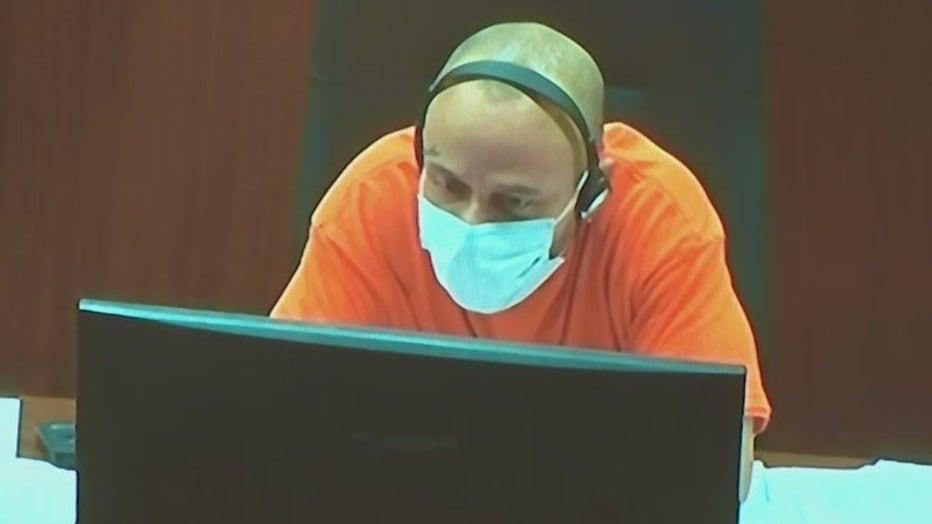
Darrell Brooks cross-examines Kori Runkel Oct. 6
Brooks asked if she ever mentioned a specific car, and Runkel said no. Brooks asked how she could identify a specific vehicle or what the person would look like. Runkel said she was told it was Darrell Brooks. Brooks said she may have been told it was "Darrell Brooks," but she couldn’t identify him.
"Erica told you that she was meeting up with this Darrell Brooks; correct?" asked Brooks.
"Correct," Runkel said.
"Did she at any time tell you what vehicle he was driving?" asked Brooks.
"No," said Runkel.
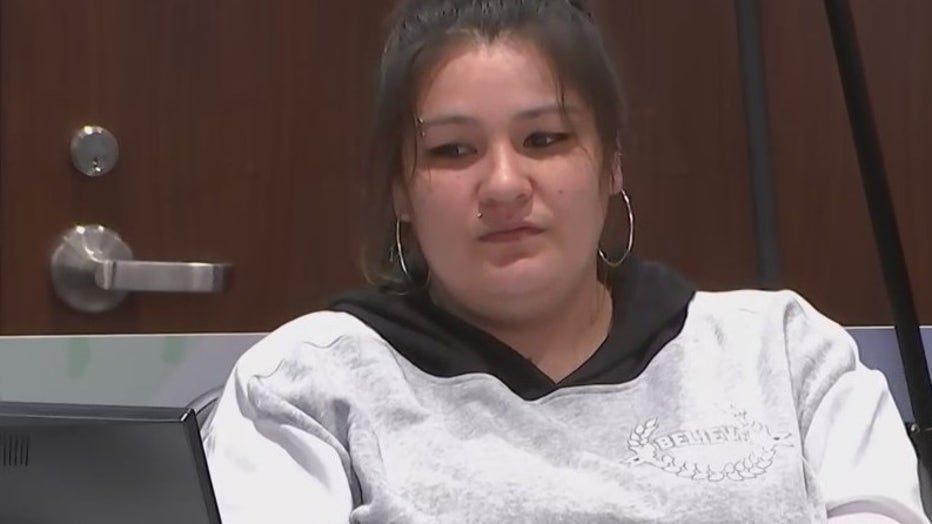
Darrell Brooks cross-examines Kori Runkel Oct. 6
Runkel established she knew that it was Brooks and his car based on what Patterson told her. Brooks asked if she was told after the SUV drove away. Runkel said yes. Brooks asked if it was fair to say she didn’t know who the driver was before. Runkel said she had a suspicion.
Runkel clarified that she identified the defendant in court and that was the same person she saw driving the SUV that day.
Brooks asked if it was true she gave a statement on what she saw and heard that day. Runkel said yes.
"Would it be fair to say that in the statement you gave that day, that you said you didn’t hear any threats directed toward Erica?" asked Brooks.
"Possibly," said Runkel.
Brooks said he had her statement in front of him. He said she didn’t mention threats. Runkel said she did mention some – that Brooks was going to kill Patterson and told her to get into the car.
Brooks asked if she wanted him to read her statement. Runkel said yes. The judge advised Brooks on the procedure for that.
Around 5:30 p.m., Brooks asked to return to the main courtroom, and the court went into recess to facilitate that.

Darrell Brooks cross-examines Kori Runkel in main courtroom on Oct. 6
Back from recess, prosecutors brought up the fact that this statement from Runkel was actually a statement written by police after Runkel gave her statement to them. Therefore, the police report was a summary of Runkel's statement vs. her verbatim statement. That statement was put on a monitor and Brooks was advised he could use that statement to ask questions.
As the jury was brought back in, Judge Dorow told Brooks he was doing a "good job" asking questions and added that she was "happy he decided to come back" to the main courtroom.
Brooks questioned Runkel about what was in the statement vs. what she testified to in court.
The defendant asked why what she testified never came up in the report. Runkel said it wasn’t brought up at the time, but it’s just in her memory.
"What exactly did you hear coming from the individual who was driving the vehicle?" asked Brooks, clarifying what point in the video he was referring to.
"Before I showed up, I heard yelling…" said Runkel.
Brooks asked how far she was from the vehicle and from Patterson before she heard anything. She answered, "I was at a distance."
Brooks asked if the conversation was hard to hear, and Runkel said, "Not really. Brooks was yelling pretty loud."
Runkel said she remembered Patterson saying she wanted to go.
The defendant asked Runkel what was said when she was "chesting up" with the driver. She answered that she was "saying Brooks should not be hitting a woman, and Brooks was saying that Erica Patterson is not a woman."
After that, Runkel said she and Brooks "started brawling it out." She said she threw "a couple punches" at Brooks, and Brooks "smacked me." Brooks asked if that was in her statement, and she said it was in her memory, and she hoped it was in her statement.
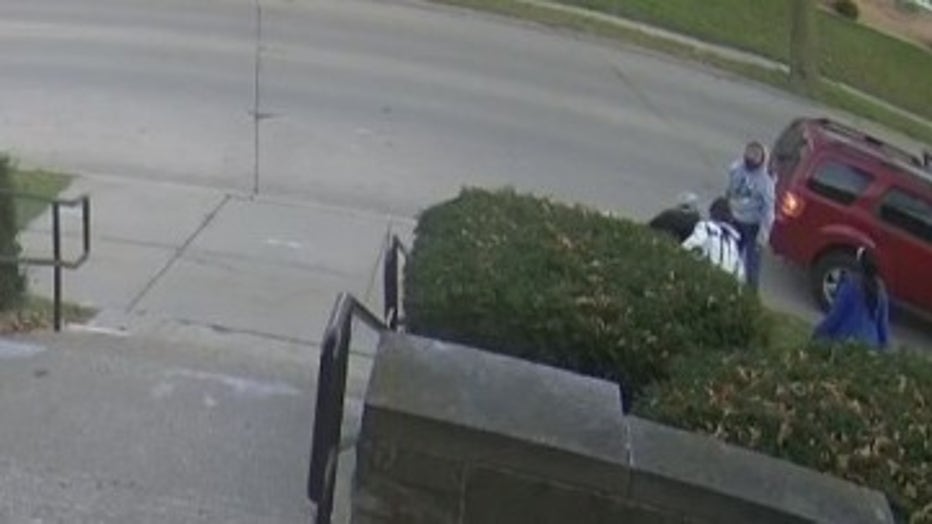
Video played during testimony of Kori Runkel
Brooks then questioned Runkel about the "brawl," which Judge Dorow called a "war of words." Brooks was asking Runkel things like whether she would report a brawl to the police after it happened, whether Runkel was knocked to the ground and whether a brawl can be seen in the video.
Runkel was shown the video again.
"At any time in that video were you, in fact, smacked and staggered back?" asked Brooks.
Runkel said that's shown in the video "at 3:23." That portion was played again.
"In the portion of the video you just saw, would it be fair to say your part, your interpretation, that you were, in fact, smacked and staggered back?" asked Brooks.
"Yes," said Runkel," saying, "No," when asked if she was "over-exaggerating it."
Brooks asked Runkel if what she saw in the video would constitute "brawling it out." Dorow asked Brooks about relevance, telling him she'd given him "a lot of leeway on this subject."
Runkel said she didn't hear anything directed at Patterson until Brooks left.
"So did you or did you not hear anything directed toward Erica after the brawl?" asked Brooks.
"No," Runkel said.
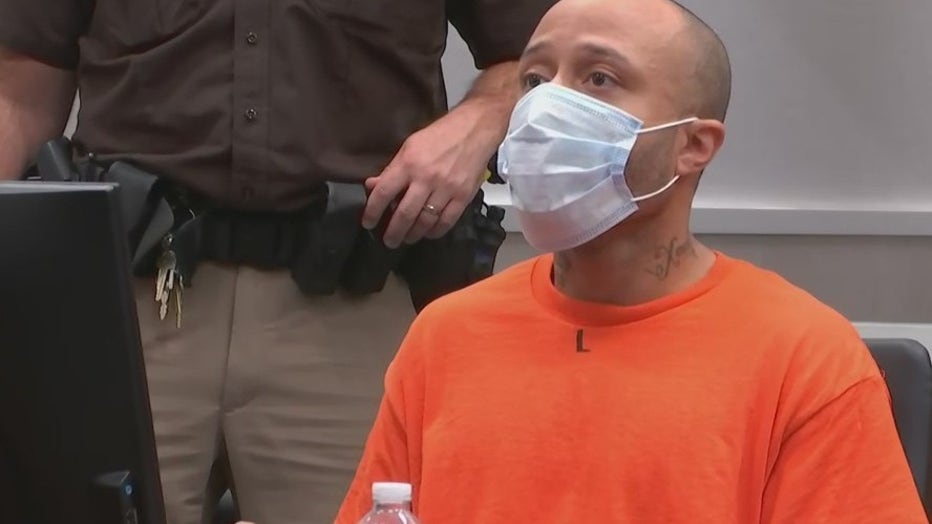
Brooks called on the state to bring up the police statement again. The defendant read from the statement, asking Runkel about a threat she said Brooks yelled. Dorow tried to get Brooks to move to a new line of questioning.
The defendant asked if Runkel was given information by Patterson prior to Nov. 21, 2021 about Patterson's relationship with Brooks. Runkel said she was. Brooks followed up by asking what the nature of that information was, and Runkel said it wasn't allowed to be brought up. The judge added that she was referencing a pre-trial ruling. Wittchow came over to point out the pre-trial motion to Brooks.
Runkel was asked by Brooks several questions about whether a knife was involved in that incident. She said there was not.
Brooks ended his questioning by asking Runkel if she knows, has seen and/or has had interaction with the plaintiff (the state). The judge sustained prosecutors' objection.
After a short redirect by Wittchow, testimony concluded for the night around 6:30 p.m. Wittchow clarified what Runkel told police and asked Runkel to identify who she "chested up" to. She pointed at Brooks.
The state had no further questions.
Judge Dorow gave the jury instructions on what not to do as part of "partial sequestration."
The court then recessed for the night.
Judge Dorow commends Brooks Thursday evening
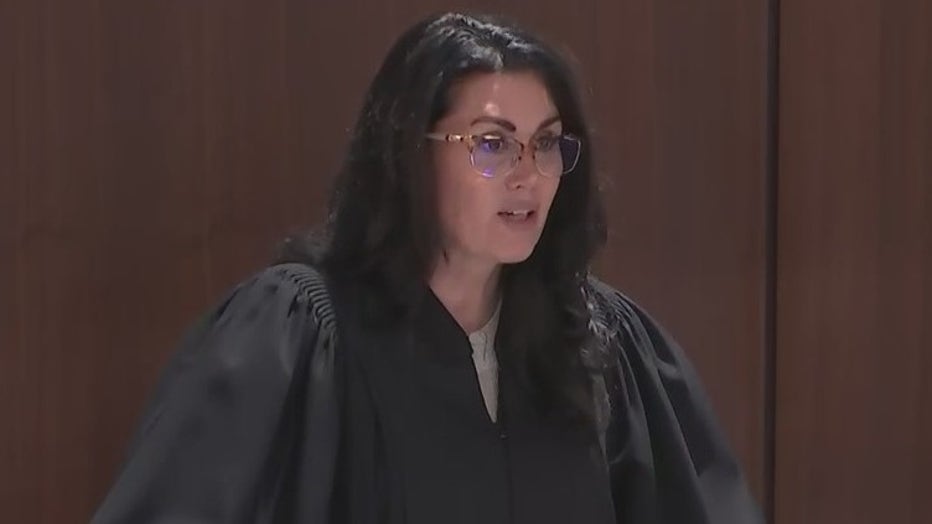
Judge Dorow commends Brooks Oct. 6 following the testimony of the first two witnesses in the Waukesha Christmas parade attack trial
After the jury left, Judge Dorow commended Brooks for returning to the courtroom and complying with the process, pointing out he did unmask when needed. She said he asked some cogent questions that sometimes went relevantly toward the witness.
"You might not always ask the best questions, but you make some relevant points," said Dorow.
She encouraged him to keep prepping.
"I really appreciate that you came back over and that you’ve been following the rules," said Dorow.
She implored him to wear his suit or other street clothes, which she said was his choice.
He made note of his pending COVID test results, saying he would feel "more comfortable" changing out of his jail attire once he knows his COVID status.
"Thank you for giving me the chance to come back in. I appreciate what you said," said Brooks.
Brooks' handwritten objection
Opper noted earlier in court Thursday that Brooks drafted an "objection by affidavit to the state's response and the court's opinions and order and defendant disclosure statement." The document was handwritten.
Christmas parade attack
Prosecutors say Brooks drove a red SUV through the parade route on Nov. 21, 2021, killing six and injuring more than 60 others.
On Nov. 21, 2021, according to prosecutors, Brooks met up with his ex-girlfriend in Frame Park, the same woman he is accused of running over with his red SUV earlier in November 2021. She told police they argued in his SUV before he started driving, and he "was driving around with one hand and striking her in the face with his other hand." She eventually got out and called her friends for help.
Soon after that, according to prosecutors, Brooks drove that red SUV through the parade route, killing Jackson Sparks, 8, Virginia Sorenson, 79, LeAnna Owen, 71, Tamara Durand, 52, Jane Kulich, 52 and Wilhelm Hospel, 81. More than 60 others were hurt.
Brooks was arrested the night of the attack, soon after telling a Waukesha resident that he was homeless and waiting for an Uber. The man was unaware of the events that had occurred and let Brooks into his home.
FREE DOWNLOAD: Get breaking news alerts in the FOX6 News app for iOS or Android
Brooks entered an insanity plea in June after initially pleading not guilty to the charges in February, a move that could have resulted in him being sentenced to a mental institution rather than prison if convicted. He later dropped the insanity plea on Sept. 9.
Darrell Brooks faces 76 charges, including six counts of first-degree intentional homicide and 61 counts of reckless endangerment. Each homicide charge carries a mandatory life sentence.

